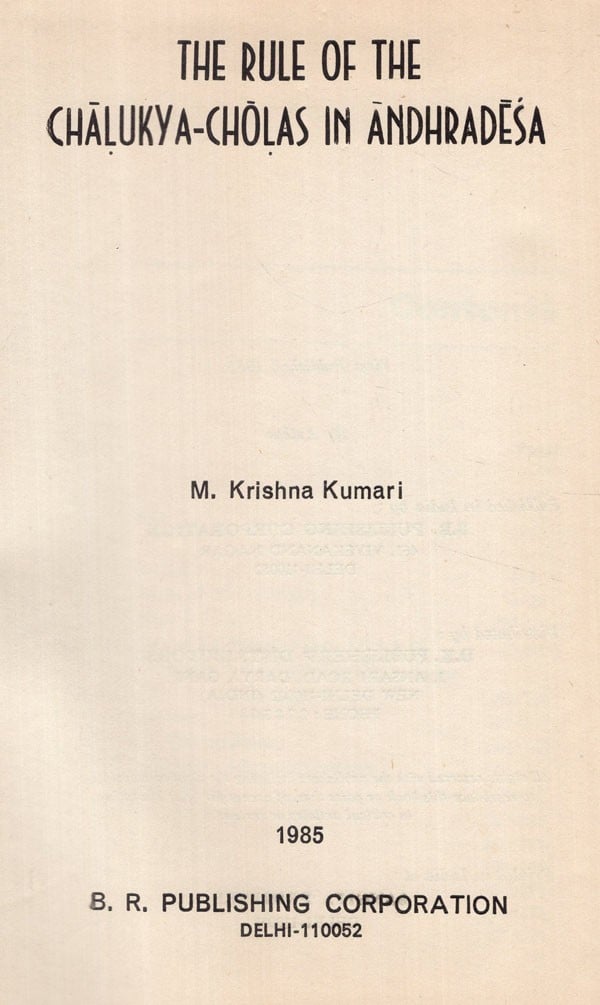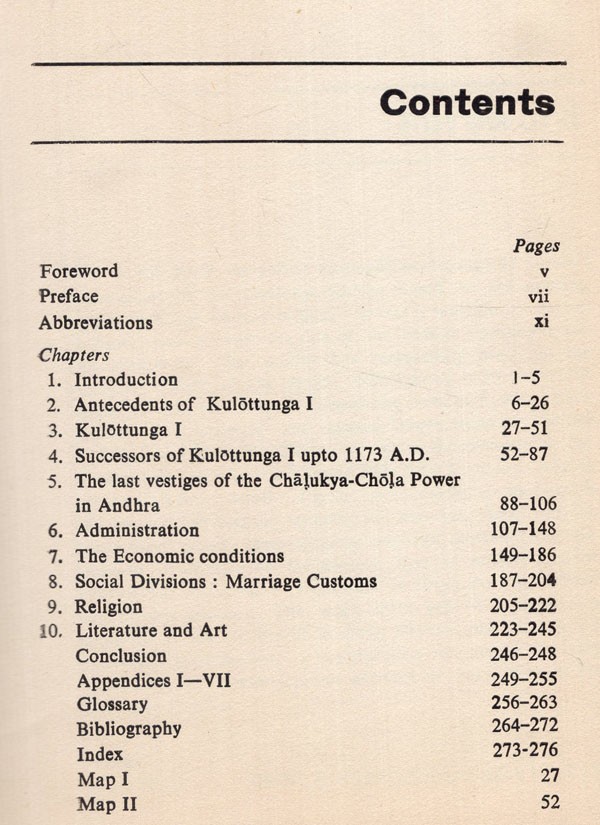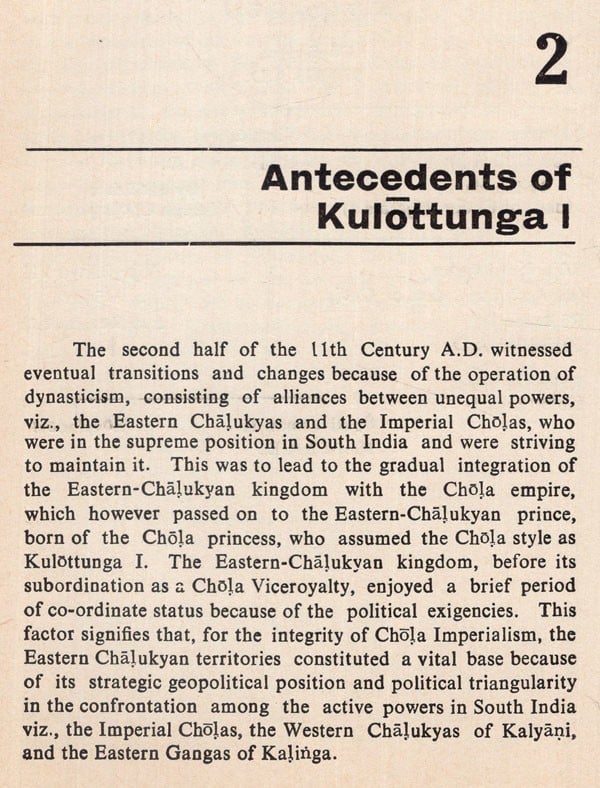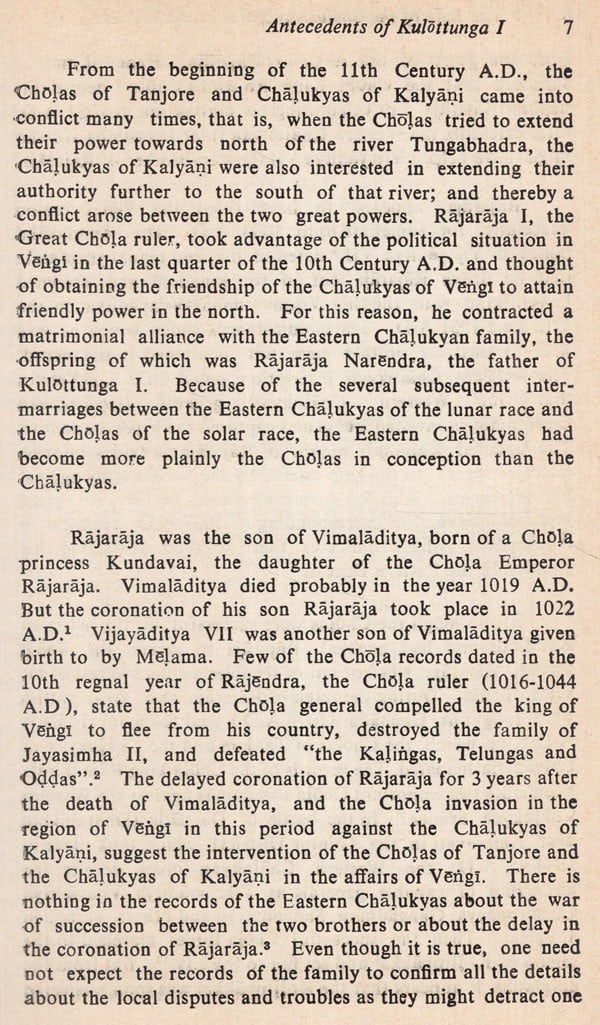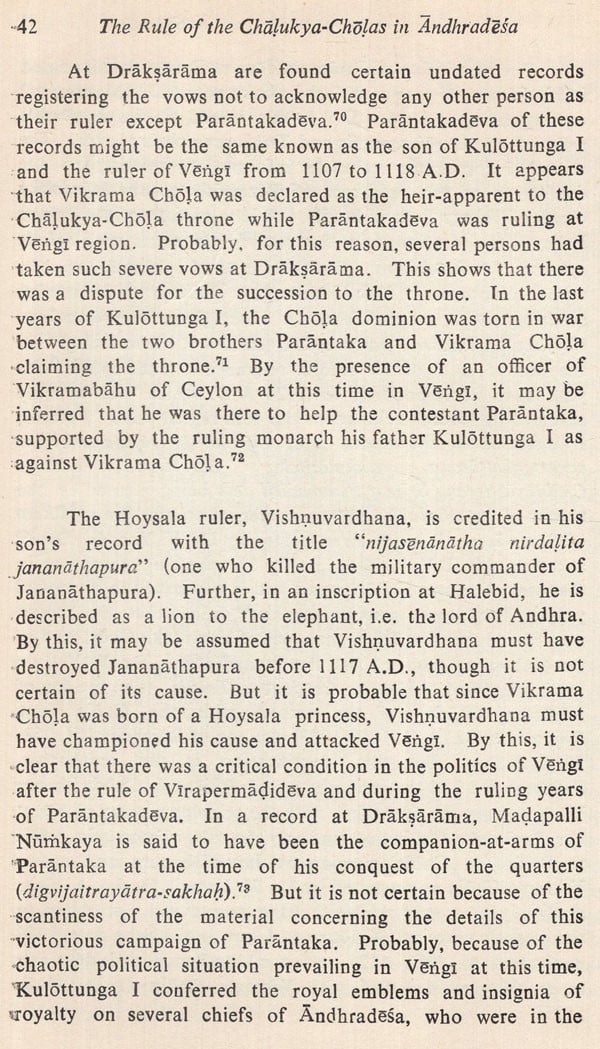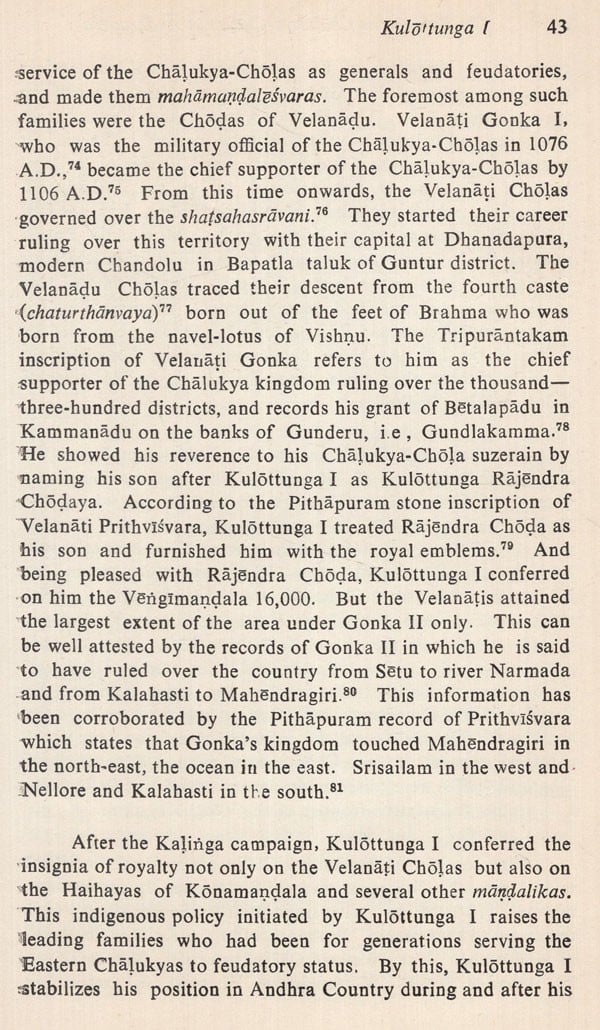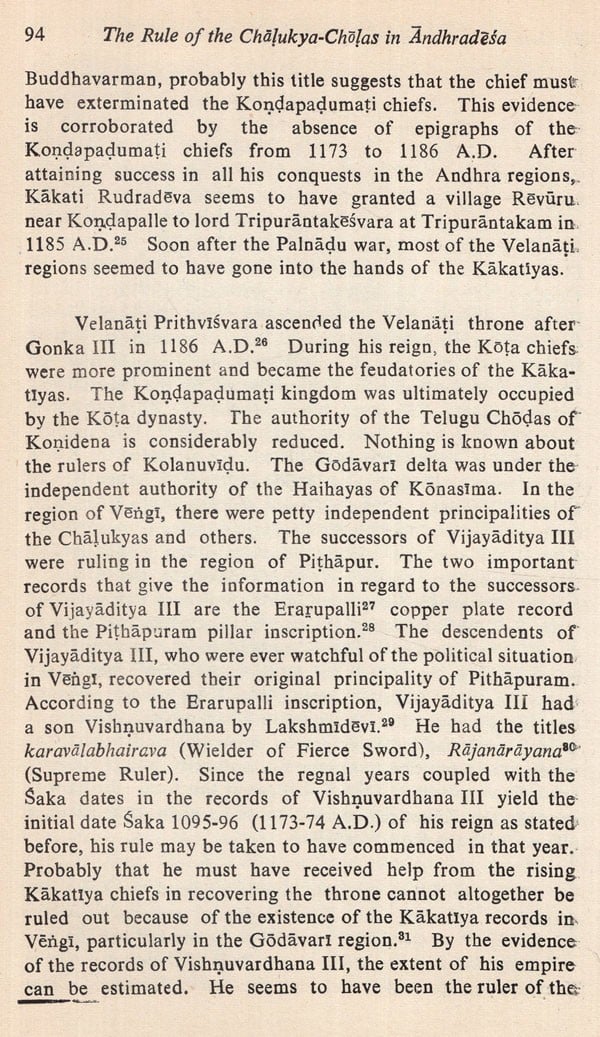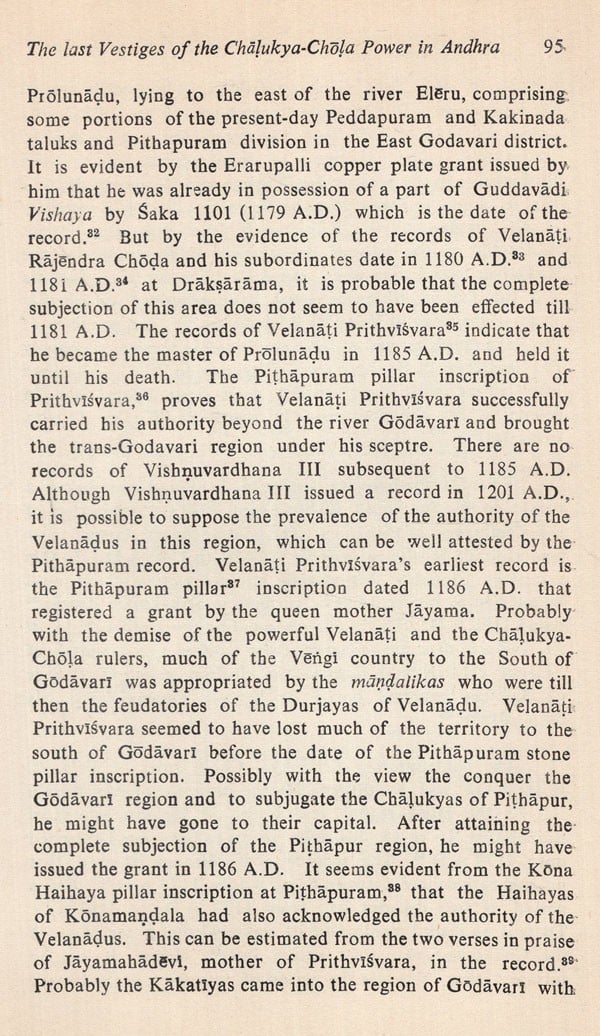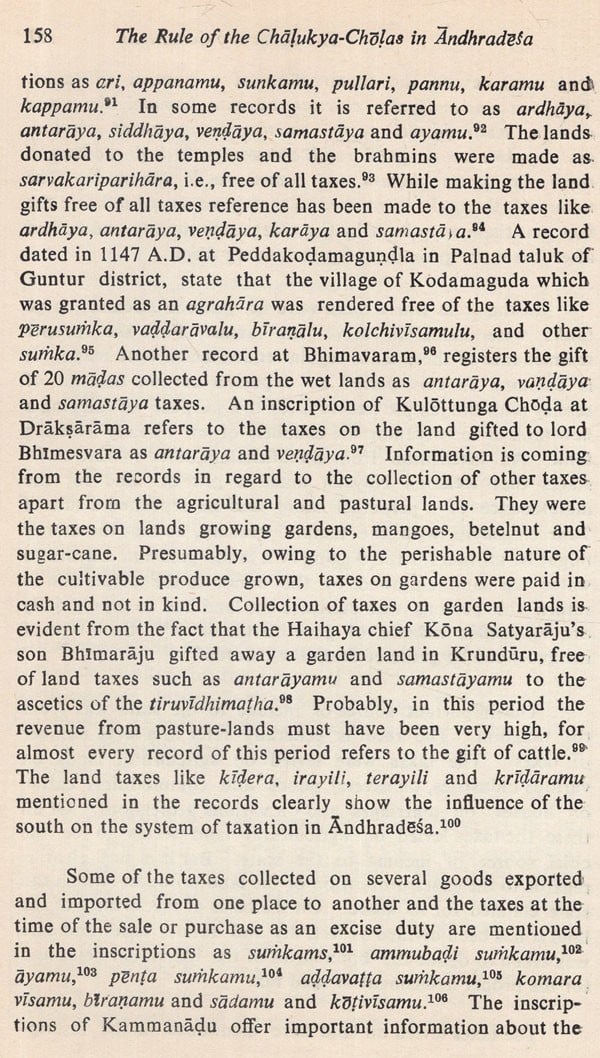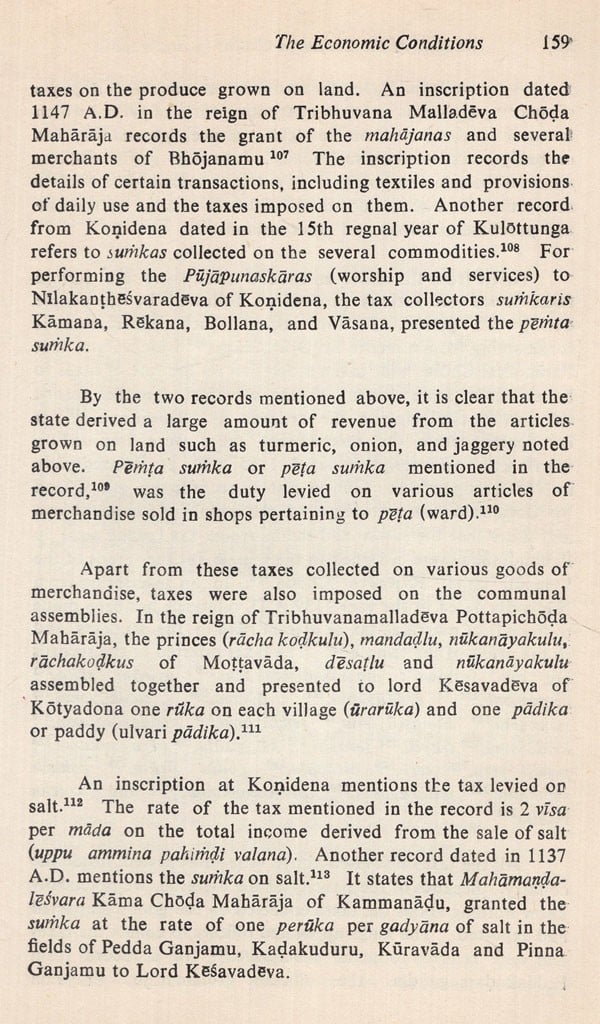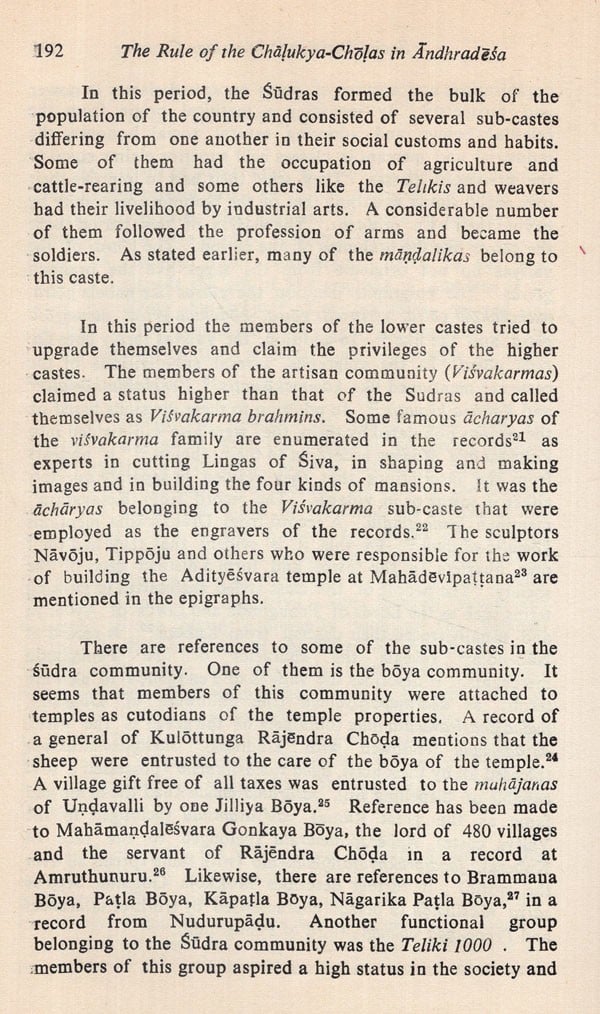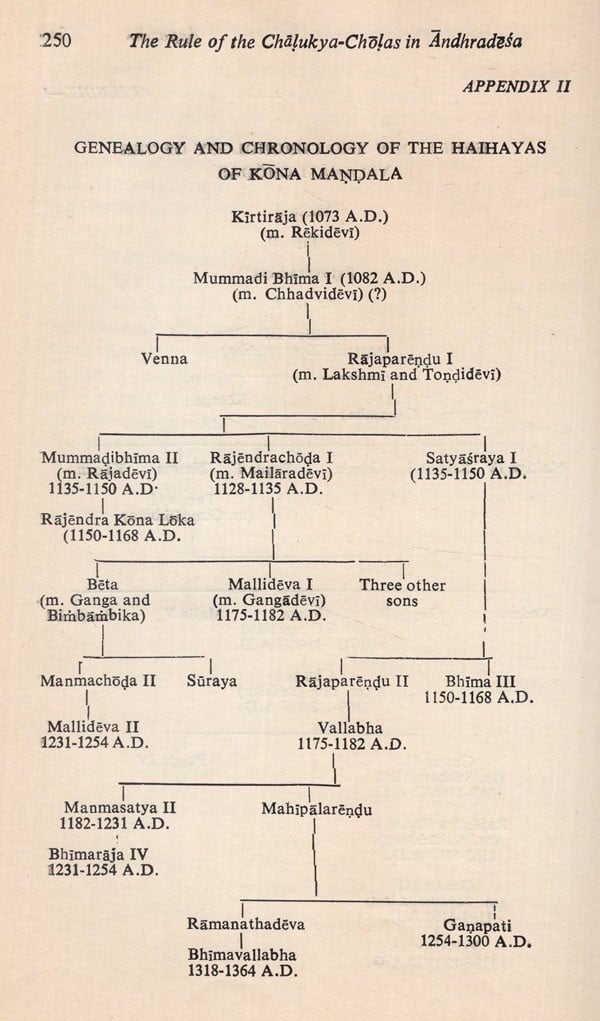
The Rule of the Chalukya-Cholas in Andhradesa (An Old and Rare Book)
Book Specification
| Item Code: | UAT253 |
| Author: | Krishna Kumari |
| Publisher: | B.R. Publishing Corporation |
| Language: | English |
| Edition: | 1985 |
| Pages: | 285 |
| Cover: | HARDCOVER |
| Other Details | 9.00 X 6.00 inch |
| Weight | 560 gm |
Book Description
The book presents an enlightening account of Chalukya Cholas, focussing the transitional phase between the rule of Eastern Chalukyas and the Kakatiyas in the Andhra history. The period of about two centuries of medieval Andhra has been dealt with multi-dimensionally: political, social, economical, architectural and religious, including the decline of Jainism and re-emergence of Saivism and Vaish navism with their further divisions. In this backdrop, the secular outlook of the rulers of that erea has also crystallized.
The book is an outcome of brilliant scholarly research, thorough probing and discerning into the existing epigra phical and literary sources. Since the chronological account of the period is not available, the author has gleaned through the stone and copper plate grants and the neglected Telugu stone inscriptions of the later Chalukya Cholas. The evidence of the Malla varam plates of Prantaka Chola have also been dealt with in this exhaustive study.
This book will open new vistas of knowledge to the researchers, general readers and students of Indian history. particularly of Andhradesa for which corroboratory evidence is scarcely available.
The fusion of the two crowns of the Eastern Chalukyas and the Chōlas by Kulottunga I, an Eastern Chalukyan prince, initiates the rule of the Chalukya-Cholas in Andhradeśa. It was the first amalgamated dynasty in the annals of Andhra. It was also for the first time in the history of South India that a person inherited an empire through his mother. Simultaneously, several dynasties rose in Andhradeśa, as major and minor autonomous powers, because of the distant and weak suzerain power.
The Chalukya-Cholas succeeded the Eastern Chalukyas of Vengl in Andhradeśa and stood as a link between the Eastern Chalukyas on the one hand and the Kakatiyas on the other. Their rule was effective in the Andhra region for a century and lingered on for another century covering an important transitional period leading to the famous Kakatiya period.
The rule of the Chalukya-Chōlas in Andhradheśa has not received the attention it deserves. So far, the chapter contributed by late Sri Mallampalli Somasekhara Sarma in Andhra Samskriti, Volume III in Telugu and Dr. V. Yasodadevi's thesis on The History of Andhra Country (Subsidiary Dynasties between 1000 A.D. and 1500 A.D.), and History of The Eastern Chalukyas of Vengi by Dr. B.V. Krishna Rao are the works available which cover the political history of this period. The works of Prof. A. Vaidehi Krishnamoorthy, Prof. K. Sundaram and Dr. C. V. Ramachandra Rao deal with only individual aspects of the history of medieval Andhra, and thus they do not make a comprehensive study of a particular period. Further, the study of other historians of the medieval history of Andhra does not observe adequately the potent and deeper influences of the commercial, religious, literary conditions and activities as they are surveys of a period of at least half a millennium, covering various dynasties. To fill in this lacuna in the history of medieval Andhra, a dynastic period, which was an important and connecting link, is taken up to bring out an up-to-date account of the Chalukya Cholas.
The present work is almost the book form of my Ph. D. thesis for which the Andhra University awarded me the degree of Ph. D. in 1979. Subsequently, the work is completely revised in the light of the suggestions made by Dr. D. C. Sircar, Prof. A. L. Basham and Dr. N. Ramesan.
The book comprises 10 chapters. The first chapter is an introduction, projecting the significance of the Chalukya-Chōla period and its place as a whole in the history of medieval Andhra. It also consists of a survey of sources. Chapter-II deals with the political situation in Andhra prior to the Chalukya-Chola rule. It deals with one of the several major problems in the study of the South Indian History, i.c.. the relations between Kulottunga I and his uncle Vijayaditya VII. whether they were on friendly terms or not. It also deals with another crucial and connected task-what did Kulottunga I do in the interval between his father's death and the circumstances in which he ascended the Chola throne. Chapter-III deals with the reign and political career of Kulottunga 1. In this chapter, a general description is given about the several Mandalikas in Andhradésa and their areas of rule. It also affords an account of the foreign invasions and the combined efforts of the mandalikas in repulsing them.
In this book, the author has made an attempt to present an account of the Chalukya-Chōlas based on the existing epigraphical and literary sources. It was a transitional period in Andhradeśa between the rule of the Eastern Chalukyas and the Kakatiyas. The author has successfully presented the political history of the period, highlighting every important detail as can be gleaned through the stone and copper plate grants. The neglected and ignored Telugu stone inscriptions. of the later Chalukya-Chōlas as well as the evidence of the Mallavaram plates of Parantaka Chola have been dealt with in greater and fuller detail. The author has made an assessment of the administration, system of taxation, trade guilds, agricultural system, socio-religious activities, marriage customs, position of women in the society, literary activity and the educational institutions in Andhra utilising the epigraphical and literary sources. This work fills a gap of roughly two centuries in the Medieval Andhra History and thus it is a significant contribution. I congratulate the author for this admirable and comprehensive account of the history of the Chalukya-Cholas.
The history of Andhra is hoary and very long, comprising various transitional periods marked with myriad vicissitudes. Since the dawn of its historic period, it underwent various mutations, by adaptation and assimilation of several others, as and when it was necessary. The Chalukya-Chola period pertains to one of such transitional periods of the early medieval Andhra. It links two great creative and flourishing periods, politically and culturally, namely, the Eastern Chalukyan and the Kakatiya periods.
The Eastern Chalukyas had matrimonial alliances with the Cholas; and, as the Chola line became defunct, the Eastern Chalukyan prince, Rajendra Choda, born of the Chola alliance became the ruler of both the Chola and the Eastern Chalukyan territories. In the year 1070 A.D. he assumed the Chola throne at the Chola imperial metropolis Gangaikonda Cholapuram with the title, Kulottunga I. The historians referred to him as the founder of a new dynasty dubbing it as the Chalukya-Chola dynasty, and referred to his successors as the Chalukya-Cholas.
In this work, an attempt is made to give a connected account of the rule of the Chalukya-Cholas in Andhradela from the beginning of the reign-period of Kulottunga I to Räjädhiraja IV. The materials to reconstruct this part of history are very few, incomplete and disconnected. The most handy source for the study of this period is the plethora of inscriptions that are found in all the regions in Andhradeśa. In South India, during the last fifty years, remarkable progress has been effected in Epigraphy as Hultzsch, Venkayya, Krishnasastri, N. Venkataramanayya, M.S Sarma, and B.V. Krishna Rao have brought out scholarly editions on many of the inscriptions. But the inscriptions of Andhra alone do not tell the whole tale. These have to be supplemented by a study of inscriptions of other regions, like Tamilnad, Karnataka and Orissa.
**Contents and Sample Pages**
